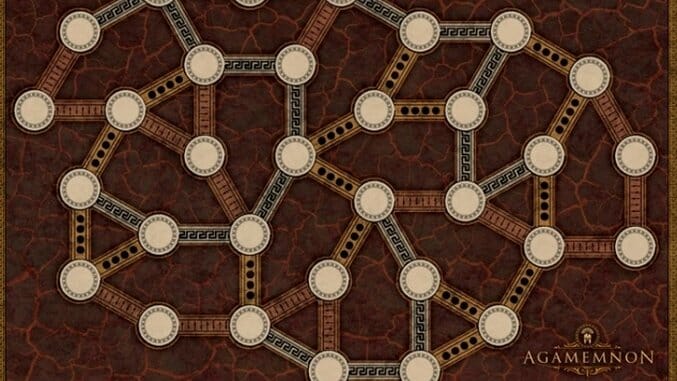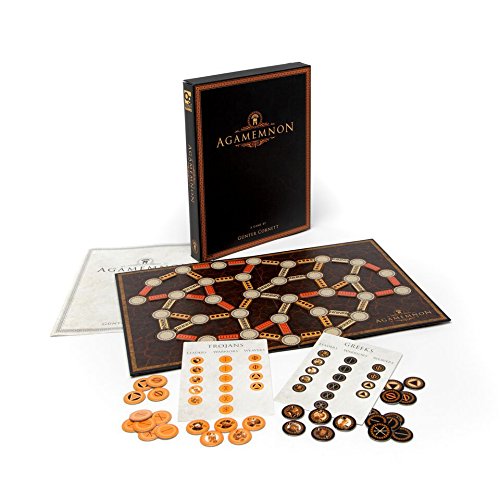
Agamemnon was my favorite new game from this year’s Gen Con, an abstract, elegant two-player game that was easy to pick up but offers enough open-ended decision-making to give the game replay value. With a low luck factor and a couple of variants available in the base game, it seems destined to join the short but growing list of great, short-playing two-player titles (along with 7 Ronin) available to folks who don’t have time for a four-hour game night on a Tuesday evening.
Agamemnon’s main board is a hub-and-spoke network where there are three types of spokes, covered with little tiles called “strings” in three different patterns, forming chains across the board. Each player has fifteen tokens that s/he will place on the board, two per turn, to try to claim various chains and end the game with the most strings under his/her control. Because these string chains intersect, however, players will have to choose to cede control of certain chains to concentrate on claiming others—making blowouts nearly impossible—with just a few tokens available to try to sabotage one’s opponent.
The three string types are controlled in different ways by player tokens, which is the heart of all of the game’s strategic decisions. Most player tokens display anywhere from one to four spears, and the first string type is controlled by the player with the most spears on tokens within that chain. Each player has five leader tokens with a letter from A to E; the second string type is controlled by the player with the highest-ranking leader on the chain (A is highest; if there’s a tie, control goes to the second-highest rank). The third chain type just goes to the player with the most total tokens on the chain regardless of face value.
Each player also gets four tokens for sabotage or redirection of strings, changing the face of the board slightly to his/her advantage. Two of those tokens sever a chain at the token—a longer chain becomes two smaller ones with a break where the token lies. The other two allow the player to switch two adjacent string tiles on the board, breaking up chains or redirecting them, potentially allowing the player to shift control of a chain over to one of his/her own tokens.

In the base game, players don’t get to choose their tokens, but draw them randomly, two per turn, as in the basic rules for Reiner Knizia’s Samurai. That involves some planning, knowing what your opponent has yet to play and what tokens you still have available for later in the game. (If you draw any of the sabotage tokens in your first two turns, you can replace them with other tokens.) It’s also the only luck-driven element in the game, and as in Samurai the effect of the randomness is small and mitigated by your knowledge of all tokens that are still unplayed. There are two more spots on the board than there are tokens, so all tokens end up on the board, although some chains may be unclaimed due to ties or due to those open spaces.
Agamemnon also includes a second layout on the other side of the board, called the Loom variant, that allows for 18 alternative alignments of strings to give the game greater replay value. The rules are exactly the same, so it’s not really a variant, just additional boards if you tire of the first one. The rulebook also suggests a variant where players separate their tokens into the three types (leaders, spears, and the sabotage tiles) and draw randomly from those stacks during each turn.
The game’s ancient Greek theme isn’t connected with the game in any way, just pasted on to a truly abstract title, but the artwork is clear and all strings and tokens are easy to distinguish. The box also is one of the only ones I’ve ever come across that’s designed to be stored vertically as well as horizontally, which is a big asset when you own too many games and end up with piles that relegate certain games to household oblivion because they’re a pain in the neck to extract. We found full games of Agamemnon took no more than 15 minutes, and setup and cleanup are quick since there are just three types of components. If you’re looking for a two-player “couples” game, something to play on a school night that won’t take too long but still exercises your mind, Agamemnon is ideal.
Keith Law is a senior baseball writer for ESPN.com and an analyst on ESPN’s Baseball Tonight. You can read his baseball content at search.espn.go.com/keith-law and his personal blog the dish, covering games, literature, and more, at meadowparty.com/blog.